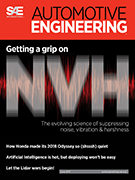Technical Paper
Cybersecurity in EV’s: Approach for Systematic Secured SW Development through ISO/SAE 21434 & ASPICE
2023-04-11
2023-01-0046
Cybersecurity (CS) is crucial and significantly important in every product that is connected to the network/internet. ...Hence making it very important to guarantee that every single connected device shall have cybersecurity measures implemented to ensure the safety of the entire system. Looking into the forecasted worldwide growth in the electric vehicles (EV’s) segment, CS researchers have recently identified several vulnerabilities that exist in EV’s, electric vehicle supply equipment (EVSE) devices, communications to EVs, and upstream services, such as EVSE vendor cloud services, third party systems, and grid operators. ...Additional processes have been defined in the process reference and assessment model for the CS engineering in order to incorporate the cybersecurity related processes in the ASPICE scope. This paper aims at providing a model & brief overview to establish a correlation between the ASPICE, ISO/SAE 21434 and the ISO 26262 functional safety (FS) standards for development of a secured cybersecurity software with all the considerations that an organization can undertake.





